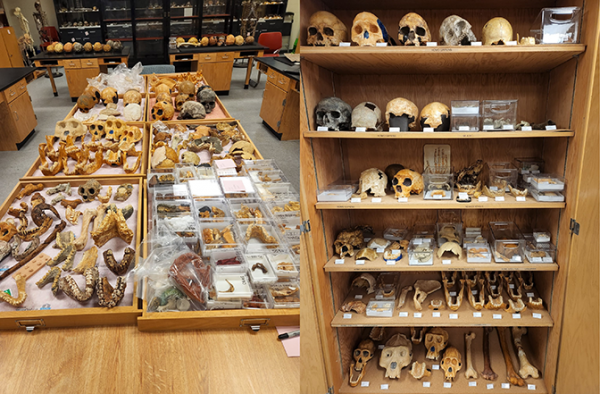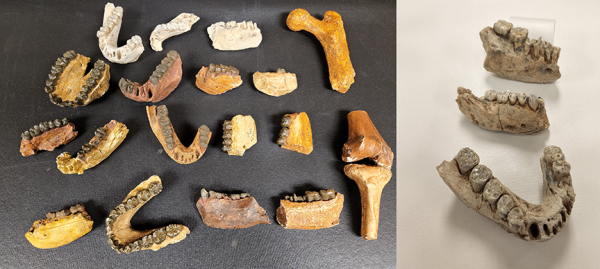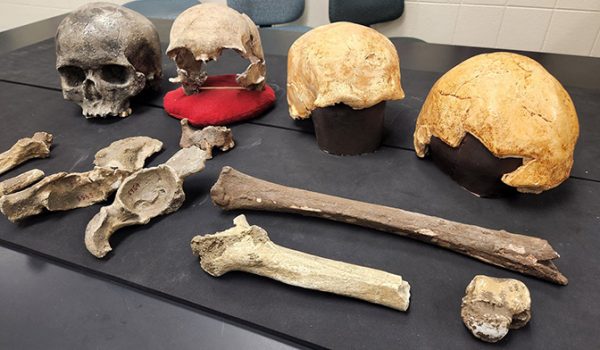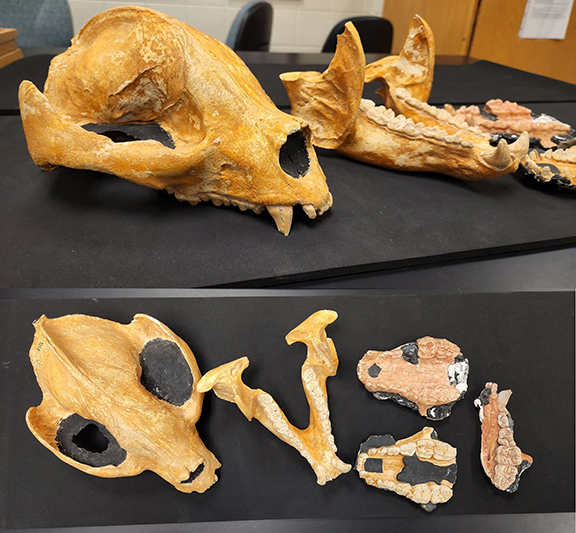Five Things! Take a tour of the Frayer Collection
Anthropology doctoral student Alex Pelissero showcases his favorite fossil casts from new department collection
September 1, 2022
Alex Pelissero
This summer, the Department of Anthropology and Geography at Colorado State University inherited a large collection of fossil casts from David Frayer, professor emeritus of Anthropology at the University of Kansas. Frayer’s research spanned many areas of paleoanthropology around the world, but his greatest focus was on the relationship between Neandertals and modern humans in Europe. Particularly of note is his work on the Neandertal remains from Krapina, a cave site in Croatia where CSU Anthropology professors Mica Glantz and Michael Pante have also conducted research.

As a paleoanthropology doctoral student, I was tasked with identifying and cataloging all of the new casts and finding them a new home in our teaching lab (known by our students simply as “the Bone Lab”). I will also be among several graduate teaching assistants who lead sections of the department’s Human Origins and Variation Lab (ANTH 121) to use these materials in lab exercises and projects that introduce Anthropology students to research methods and theories that help people understand evolution and adaptation. The collection includes a wide array of specimens of humans, primates, and our ancestors from around the world.
Having exhaustively reviewed and handled the collection, here are a few casts that I found to be especially interesting and exciting from this collection.

#1: Australopithecus afarensis from Hadar, Ethiopia
These are the casts that I am most excited to have in our collection, all from an early human ancestor known as Australopithecus afarensis, from the Hadar site in Ethiopia. Hundreds of fossils of this species, including the famous “Lucy” partial skeleton, have been found at this site, all over 3 million years old. However, apart from Lucy and a few other well-known specimens, casts from Ethiopia are very hard to come by. Some of the casts the department has received are really beautiful — they almost look like the real fossils! In this group from the Frayer collection, we have a mix of upper and lower jawbones, but also some leg fragments from a single individual.

#2: Omo 2 from Omo-Kibish, Ethiopia
This is Omo 2 — a rare cranium cast I was personally really excited to handle, but had to get glued back together after it was damaged in transit. It is one of the oldest fossils attributed to anatomically modern Homo sapiens — super cool! It is roughly 195,000 years old, and comes from Omo-Kibish, Ethiopia. The cranium has some primitive characteristics that it shares with earlier humans like Homo erectus, but is very modern in many respects. It has been debated whether to place this specimen in a more archaic taxa, but given the appearance of the current oldest fossil attributed to our species (a roughly 300,000-year-old cranium from Jebel Irhoud, Morocco), the case for including Omo 2 in with anatomically modern humans is much stronger.

#3: Humans from Mladeč, Czech Republic
This is a nice group from fossils that are 31,000 years old from Mladeč, Czech Republic, and they were a surprise to us! A lot of these casts weren’t listed in the catalog, but thankfully I found David Frayer’s chapter from a great 2006 volume on the remains, which was crucial in determining who they were!
The remains are a mix of males and females from multiple individuals. The postcranial remains are really interesting, as they show clear evidence of carnivores chewing on them. Since they were first found in the 1880s, the Mladeč remains have been central in the debates about the appearance of anatomically modern humans in Europe, and what relationship they had with Neanderthals.

#4 Giant Lemurs
Included in the Frayer collection was a diverse number of primate casts, stretching from the earliest primates 60 million years old to more recent specimens from living apes. There are several fascinating casts, but I found these to be particularly interesting. They are from a few different species of several thousand-year-old “giant” lemurs from Madagascar. These animals existed alongside their smaller, still living relatives on the island up until fairly recently. When humans first arrived on Madagascar about 2,300 years ago, hunting and deforestation unfortunately drove these large, slow-moving primates to extinction.

#5: Pandas?!
These were some of the more unexpected casts from the Frayer collection: Pandas! Fossil pandas (genus Ailuropoda) have been found at many sites across southeast Asia and China, including at the same caves where fossils of Gigantopithecus have been found. The incredibly heavy, complete skull and the dental casts were likely used as comparatives for the fossil pandas. While cataloging, we found out that these casts were made from molds taken from specimens at the Field Museum in Chicago. Neat!
The Frayer Collection is housed in dedicated space in a teaching lab and will be primarily used in research, lab activities and projects, and outreach.
The Department of Anthropology and Geography offers tours to prospective and current CSU students, alumni, and school and community groups. To inquire about a visit, email cla-anthro_info@mail.colostate.edu. Prospective CSU students can also contact the College of Liberal Arts to arrange a visit.